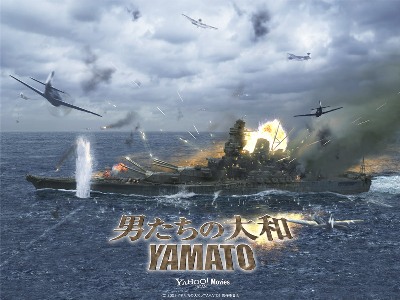| 世界に学ぶ、日本を知る |
|
RECENT ENTRY
水時計−時を刻む水の滴
ポセイドン見て、おぼれ死にかける またハリケーンがやってきますよ プロ野球から草野球までデータ野球 忘れモノをめぐる日本の均衡点 遺産を守るのが進化のバロメーター 今年買った本のお薦め(更新) サルでも分かるダビンチコードの面白さ 緑の選択、復元・復興・再生 炭酸締出し、わざわざ政治がやること? ナイロビの蜂に見た思いあがり ロシアの「今」で民主主義を考える 世界の100人に選ばれた小泉首相の実績 地球を画面に感じる、プラネットアース 竹島問題にて、「売国土」は売国奴? 「V」が示す自由への自負と警鐘 北朝鮮の、遠かざる夜明け ベトナム経済の再起動、日本も協力 ダ・ヴィンチ・コードは事実から創作へ? 広告ビジネス新時代の競争に「看板」
May 2007
CATEGORY ARCHIVE
お知らせ(7)
本物の英語情報:Magazine; Books; Movies(73) 英語を学ぼう:Let's English(11) 世界の空(中国特集):World and China(14) いいじゃない:Don't worry(20) かわいい兄妹:Tecodeko(28) |
この映画に行く前は、日本の愛国心をあおる「正しい歴史」を示そうとした映画だと思っていました。ところがこの胸におさめてみると、従来と変わらない戦争観を描いたものだと感じました。『男たちの大和』というより、福井晴敏風のタイトル『亡国の夢・大和』??。 「本物の話題」を「ホンモノの英語」でお届けします、 ニュースから、映画・雑誌・洋書のガイダンスまで。
Sixty years after it was sunk, the Imperial Japanese Navy battleship Yamato is about to recreate her final journey -in cinema screens across Japan. (以上、Battleship Yamato resurfaces on screen―Aljazeera.Netより)60年前に沈没した、帝国海軍の戦艦大和が再びよみがえろうとしている。最期の航海が、スクリーンにお目見えするのだ。 “I want this to be more than just a successful film・・I want people to have more pride in Japan and a sense of responsibility.” まずは、映画を製作した角川春樹氏の言葉を紹介しています。原作『男たちの大和』
The largest battleship in the world when she cast off from the docks at Tokuyama, southern Japan, on 6 April 1945, the Yamato had been an icon for the nation when its empire stretched from New Guinea to the Russian frontier. (当時なお)世界最大の戦艦として、大和が徳山を出発したのは1945年4月のことだ。国家のシンボルとされた大和の時代とは、帝国の戦線がオセアニアからロシアまで延びきった状態にあった。 In the last months of the second world war, however, the increasingly desperate Japanese leadership preferred suicide charges to surrender and pressed the pride of its fleet into the most spectacular of kamikaze raids. Japan's relations with China and South Korea have been at a low ebb in recent months, largely over what its neighbours see as Tokyo's downplaying of its war-time atrocities. 原作に忠実に制作しているだけでなく、史実をも正確に反映させようと苦心したところなどが、アルジャジーラーのこの記事にも取り上げられています。それは、製作者側の話をきちんと引用している点に、表れていると思います。さすがアルジャジーラ。佐藤純彌監督が語ったという三つのポイントを見てみましょう。
Firstly to focus on the thinking of the time and show that those who take power through force will lose it in the same way. まずは、時代の考え方に焦点をあてました。示したかったのは、権力を手にした人々がそれを失うときの、共通点です。 Secondly that these were young and innocent people sent to their deaths and that it is clear those who bore the responsibility for that were the political leaders. Thirdly, I wanted to look at the current state of Japan and what we must do to make it better. そう話す佐藤監督は他のインタビューでも、愛する人を守るためには戦争をしない、戦争をしないためにはどうすればいいか、と問いかけています。この映画が、その問題に対する答を示してくれているかどうかは、議論百出だと思われますが、僕は、映画の中で、臼淵大尉(長島一茂役)の言葉が印象に残っています。 敗れて目覚める、それ以外にどうして日本が救われるんだ
The ship and its hapless final hours have a certain resonance in the Japanese national psyche. For some that final mission was the epitome of youthful sacrifice, while others viewed it as an act of unforgivable folly by a leadership that already knew the war was lost. (以上、Battleship epic reignites anger over Japan's wartime excesses―Guardian)戦艦と、不幸な最期の数時間は、日本人の国民心理の琴線に触れた。最期の使命とは、若者が犠牲になるという構図に表れていた。しかし、他方で、戦争に負けることを知っていた政治家たちの愚行だともみなせる。 But elsewhere in Asia the $25m film risks evoking bitter memories of the war and accusations that Japan refuses to recognise the costs of its wartime experiment with ultra-nationalism. The film, one of the most expensive in Japanese cinematic history, barely mentions the origins of the war or the events leading up to the ship's doomed final mission. ・・“I feel very strongly that the anti-Japanese demonstrators were acting without knowing about Japan and it was the result of government propaganda・・My message is about people's courage to live, and I want people to start thinking again about how to live with self-awareness and pride as Japanese・・We don't label it an anti-war film, but the message is very clear. We are depicting the events of 60 years ago to get across the idea that we never want to go to war again.” ここでも角川氏の強いメッセージが紹介されています。 僕は、海外の人々にぜひこの映画を見てもらいたいと思いつつ、果たしてこの映画で、どこまで理解されるのかという不安も抱えたままです。中国に留学していた僕は、場所が瀋陽(日中戦争の勃発した場所)だったせいか、喧嘩に何度か巻き込まれました。自分たちも同じ被害者だといくら説明しても分かってもらえませんでした。
(アメリカ人と日本人との神風特攻隊に対する印象はずいぶん異なる。このサイトは、第二次大戦末期、特攻して行った若者たちの肖像や認識などを多様な視点で考えてみたいと思う。)
American military men on ships off Okinawa and the Philippines also watched many Japanese suicide planes bursting into flames and falling into the sea without ever reaching their intended targets. (以上、American Views―Kamikaze Images)米軍が、沖縄やフィリピンの船上で見たのは、多くの日本側の戦闘機が、炎を上げ海へと散っていく様だった。目的も果たせないままだ。 ・・nearly all Americans know little more about "kamikaze" than the word itself. Most Americans realize the word refers to anyone who engages in reckless behavior without regard for personal safety. The media sometimes refers to terrorist suicide bombings as "kamikaze attacks" or "kamikaze bombings. Even in the years after censorship ended, there have been only a small number of English books giving the history of individual pilots・・but the books did not have any substantial influence on Americans' perceptions of Japan's kamikaze pilots due to their relatively limited distribution.
The Japanese people who said farewell to kamikaze pilots saw them wave goodbye with smiles and remembered them with affection. Those left behind saw nothing of either their being shot down from the sky or their crashing into American ships, so they remembered the pilots as young heroes who bravely went to their deaths in defense of their homeland. (以上、Japanese Views―Kamikaze Images)日本人が神風特攻隊に別れを告げ、笑顔をもって見送った。そして、愛をもって記憶にとどめた。残された人々は、彼らが撃墜され、米軍に突っ込む様子などを目にすることはなかった。ただただ国土を守るために死んでいく彼らを英雄視するばかりだった。 Over the decades since the end of the American occupation in 1952, kamikaze pilots gradually have regained the status of national heroes that they once enjoyed during the final stages of the war. Japanese people today shed tears when they hear the stories and read the last letters of young kamikaze pilots who gave their lives in defense of their country. This tragic loss of life came about from the desperation of the Japanese military to come up with some strategy and battle tactic to stop the relentless advance of Allied forces toward Japan. 今日の日本人は、神風特攻隊の最後の手紙を聞いたり見たりして涙を流す。国を守るために散っていった命である。この悲劇は、日本の軍人たちによってもたらされた。軍部は、戦略をもって、列強の過酷な外圧を取り払おうとしていたのだ。

# “公開12日目で100万人を突破し、東映58年の歴史で最速記録”
Posted by cancheer 06:28 AM | 固定リンク
この記事のトラックバックURL:http://kupppy.s57.xrea.com/x/mtsys/mt-tb.cgi/328 TRACK BACK
自己啓発の本なんか捨てちまえ!?仕事がないなら株をやればいいじゃない・・・ちょ〜ゴーマ〜ンww(Hellsing風で)
やっと年賀状描き終わったw・・・と言っても出すのはとりあえず3枚だけという罠wイラストで無駄に時間かかってるだけで。今週号の「さよなら絶望先生」のデッドスペースの話でケータイのメモリ1000件のうち990件はデッドスペースですよ!wみたいなネタがあったがケータ... 「憂國変態妄想日記」のサイトから Posted at 2005.12.30 07:44
絶対に観ない映画「男たちの大和 YAMATO」
世の中には観たい映画もあれば、絶対に観たくない映画もあるわけで。 今日はそんなお話です。 その観たくない映画とは… 「流線型事件」のサイトから Posted at 2005.12.30 15:01
映画『男たちの大和/YAMATO』
~ もう会えない君を,守る.~昭和20年,4月7日にアメリカ386機の艦載機による波状攻撃を受けて沈没した戦艦『大和』と3000名ほどの乗組員の運命を描いた大作.■ストーリー2005年,鹿児島県のある漁港.60年前に沈没した戦艦大和の沈没地点まで船を出して欲しいと願い出る... 「Trace Am's Life to Success」のサイトから Posted at 2005.12.31 22:35
「男たちの大和」昭和は終わらない
「男たちの大和」★★★☆ 反町隆史、中村獅童、松山ケンイチ主演 佐藤純彌監督、2005年日本 あえて言うなら 無駄な死を目にして 悔しくて堪らなかった。 無駄な死というより 無残なと 言い換えた方が正しいのか。 戦争に行くということは 死ぬかもし... 「soramove」のサイトから Posted at 2006.01.05 18:51 |
|
||||||||||||||||||||||||||||||||||||||||||||||||||||